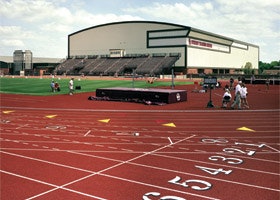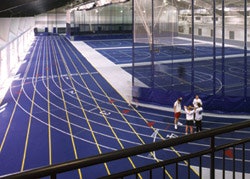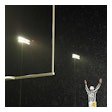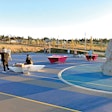
Since the first "foot race" of the ancient Olympic Games, the sport of track and field has evolved into a core component of high school, collegiate, amateur and professional athletic programs around the world. What makes designing and equipping facilities for this particular sport a marathon rather than a sprint starts, of course, with the fact that track and field encompasses multiple athletic events. Careful consideration of several factors is essential to the planning process, including location, infield and multiple-event functions, and selection of surfaces, equipment and lighting.
Creating top-notch facilities with this kind of attention to detail is nowhere more important than on college campuses. While track and field does not own the recruiting cachet of football or basketball, college sports programs on the whole help to attract and retain a diverse population of students. As training and competition facilities for revenue sports have become ever more opulent, student-athletes across the board have come to expect their sports to receive the same treatment. "For athletes," notes Jennifer Potter, women's track and field coach at Ithaca College, "influential factors determining which school they choose can range anywhere from the quality of locker rooms to the number of spectators who attend an event."

For athletes, track and field is all about incremental improvement - better times, farther throws, higher jumps. Improvements to track and field facility design have similarly come gradually over the years.
A timeless issue in facility development is the scarcity of available land. While the trend in professional sports is the development of dedicated, single-sport venues, most colleges and universities are faced with the challenge of accommodating a number of different sports within one facility.
For example, the State University of New York at Brockport's new indoor "House of Fields" facility will be home not just to the men's and women's track programs, but to a variety of the school's athletic teams. "Our current athletic facility is simply inadequate for the needs of our larger program," explains athletic director Linda Case. "It's a basketball facility that can be used for limited track and field practice, and the only events it hosts are two annual wrestling tournaments. With the new facility, we are planning to accommodate practice space for track and field, football, soccer, lacrosse, field hockey, baseball, softball and tennis - and all of those will require different striping, equipment and storage."
Of these, adequate storage is the most universal need. Track and field's abundance of large and cumbersome equipment includes pole-vault and high-jump pits, which must vie for storage space with hurdles, nets, goals, cages and equipment for the various events. For that reason, the size and location of storage areas are critical to the success of a planned multiuse field house.
Jim Nichols, the men's track and field coach at Ithaca College, says that functionality is the most important characteristic of a facility that hosts track and field events. "Being able to manage the flow of athletes to and from their event spaces is crucial," he says. Indeed, few things are as important when a high number of athletes and teams are involved - except, perhaps, for the ability to manage the flow of event participants within a complex of related facilities. For example, the U.S. Olympic Track and Field Trials will be held at the University of Oregon's Hayward Field next June for the first time since the venue hosted three Olympic Trials in a row (in 1972, 1976 and 1980). According to Stephanie Hightower, chair of USATF Women's Track and Field, a key to the selection of Oregon as the 2008 host site (aside from its history as "Track Town, USA") was the proximity of nearby facilities for practice during the events, as well as the size of the stadium (USATF requires a minimum of 30,000 seats for Olympic Trials). To attract the highest-profile meets, new tracks must serve the sport's various governing bodies while still accommodating the many other uses of the facility.
Both the International Association of Athletics Federations and the National Collegiate Athletic Association publish facility specifications for the design of track and field venues. The traditional standard for an outdoor track has long been an eight-lane, 400-meter track with two parallel straightaways and two equal semicircular curves. This type of track, with straight sections measuring 84.39 meters and equal radii of 36.80 meters, encloses a field that can also be used for football or lacrosse (the most common setup at the high school or small-college levels). Track lane widths in this configuration range from a minimum of 42 inches up to 48 inches.
A ninth lane may be designed for an outdoor track and is often built into larger university track and field facilities. While not strictly necessary, a ninth lane shortens the length of time to run meets and is perceived to increase the prestige of the venue. The decision whether or not to add a ninth lane is largely budget driven, as it is the longest and most expensive lane to construct.
A broken-back track, meanwhile, also known as a double-bend track, is a 400-meter outdoor track that allows for a wider infield that can accommodate an NCAA soccer pitch.
The configuration of the 400 meters and the choice of infield sports is a decision each institution makes based on its overall needs. However, the grade, slope, curbs and markings of the track are established within very narrow tolerances as specified in IAAF and NCAA track and field manuals.
The length of a standard indoor track is 200 meters, although it is allowed to be of any length up to 300 meters. The number of lanes can vary, with six lanes being typical on the curves and eight lanes on the straightaways. If the field house has retractable bleachers on the main floor, additional straightaway lanes can be striped for practice.
Indoor track design must account for safety zones behind the starting line and beyond the finish line. The NCAA sets a minimum of three meters clear distance behind the starting line, and recommends a 20-meter clearance beyond the finish line (the minimum allowable is 10 meters).

From the track materials underfoot to the proximity of various field event venues, facility design has never been more focused on safety. Meanwhile, precision timing and distance-measurement tools have led to great strides in accurately quantifying athlete performance - and separating winners from the rest of the field. These, designers say, are the three areas most responsible for bringing track and field to the modern age:
Surface Specs. A high school and collegiate athlete in the 1970s, Hightower still has a few cinders in her knees as a reminder of outdoor tracks she ran on in the past. In the late 1980s, the IAAF established performance specifications for synthetic-surfaced outdoor tracks, setting standards for surface thickness and drainage, friction tolerance and tensile properties. In most cases, the specs are so highly prescribed that most end users choose a track based on simple preference, leaving the details to qualified installers.
Today's all-weather outdoor and indoor tracks consist of either rubber or polyurethane materials and are installed as sheet goods or layered poured-in-place products. Modern surfaces' most important characteristic is their ability to withstand the assault of athletes' spiked shoes, while the prospective track owner's most difficult decision involves the way the spike-resistant track surface will combine with whatever infield surface is selected inside the field house. (Outdoor tracks' infields are made of either grass or synthetic turf, so this is strictly an indoor issue.)
Spike-resistant track surfaces are designed with a rough, embossed, encapsulated or embedded non-slip texture specifically for track athletes' speed and agility. Also available for infields is a somewhat smoother surface designed specifically to accommodate tennis. Ensuring that both surfaces are spike-resistant is important because it gets rid of the necessity to keep track athletes off the infield. However, when an indoor track facility will be used for other sports such as soccer or lacrosse (for practice or recreation), it is generally not advisable to mix two surface textures, as moving from one to another surface can cause injury because of differences in friction and grip.
Time Tech. Quantifying the measurement of time and distance is the crux of competitive athletics, and equipment such as automatic timing systems has played an enormous role in advancing the sport of track and field.
The accuracy of fully automatic timing (FAT) systems with digital photography has dramatically improved meet management. Multiple redundant cameras capture and collect finish-line data that is transferred automatically to a computer. This split-second accuracy eliminates human timing errors and disputes. Timing system software is designed to integrate finish-line data with the previously entered athlete's names through a wireless transmission. Event results can then be immediately displayed on a computer or interface with multiple manufacturers' scoreboards. Fully automatic timing systems consist of multiple components that can be built upon, making an initial purchase affordable for high schools and clubs, as well as colleges and universities.
Throwing Fits. The golden rule in any sport is "Safety First." If you spend enough time around track and field meets, you know firsthand the huge potential that exists for injuries to occur. Some of the more dangerous events, such as the weight throw (indoors) or the hammer throw, discus, shot put and javelin (outdoors), are commonly performed on the track's infield. It is imperative that the design takes these events into consideration, both as standalone sports and as events that will be taking place while others are happening around them.
To that end, many colleges and universities plan dedicated throwing areas outside the infield as part of their field houses. Typically, the throwing area is a double-height space in the range of 3,000 square feet that opens to the larger volume and may be separated with a fence for spectator safety.
Indoor venues pose a number of safety issues, such as the heights of ceilings and any hangings, projections from walls, nearness of walls to event locations and placement of throwing nets. Typically the pole vaults are laid out in the center of the infield - or below the ceiling's highest point - to provide enough clearance. Other uses - such as football or volleyball - may require their own ceiling specifications, which must be considered in the context of field events.
Outdoors, changes in infield surface specification are leading to alterations in the traditional configuration for throwing and jumping events. As an increasing number of venues are being specified with synthetic turf infields, for example, the javelin and hammer events are being forced outside the infield due to maintenance and warranty concerns. This has an impact on the amount of land required, and thus on the potential project cost. As a solution to this problem, some schools are overlapping throw areas with practice fields.
The wider infields required for lacrosse and soccer have in many venues moved the long jumps, triple jump and pole vault to the end zones or outside the track to allow for adequate run-out areas.
Changes to the design of hammer cages over the past four years have significantly reduced, but not completely prevented, the possibility of errant throws. The sector for a legal throw remains 34.92 degrees, but care must be taken to create a "safety zone" - a classic misnomer, since this refers to the still-unsafe portion of the field - of perhaps 10 degrees on either side, for a total landing/safety zone of roughly 55 degrees. Other throwing events are typically located to minimize overlap in landing areas, so that concurrent events can be run (and without inadvertently introducing a javelin-catching event). If necessary, however, designers can overlap part of the landing areas of certain throwing events to save on space.
The design of the entire facility needs to be studied to allow adequate safety, based on the amount of land available, and planned from the meet management perspective - how all events will be run efficiently. This may require tradeoffs, with an understanding that if a greater number of events need to overlap in areas, the scheduling and length of meets will be affected.
It is incumbent on all architects, facility owners and facility users to ensure that the facility and its equipment are safe and fit for the purposes for which they were intended. Apart from building regulations, a number of codes and recommendations exist that apply to both outdoor and indoor venues. The IAAF and NCAA are the arbiters of construction and event safety for all track and field events.

A new venue that can host track and field events can be an enormous benefit to any high school or university. Making a successful facility happen requires the insight and perspective of a variety of sources - athletes, coaches and sports administrators - so good communication among all interested parties is vital.
Athletics dates to the classical era, with running being the original event at the first Olympics in 776 B.C. Elements of field events survived as part of the Roman gladiator games and flourished in the Middle Ages as part of warrior training. Today, a track and field meet is a gathering for athletic competition but also a showcase of spirit and uplift - what SUNY's Case calls "a festival, a celebration of athletics." Proper design of your new track facility will ensure that it is well suited to the school and its community - and that its functionality will be celebrated by the many people who will use it.
































